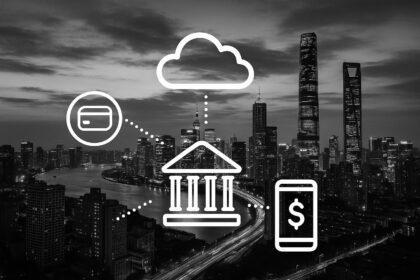As digital currencies surge in value, cryptocurrency executives face escalating risks from violent kidnappings and targeted criminal activity, prompting increased investment in personal security. Concurrently, controversies around AI chatbots and AI-driven advertising highlight mounting concerns over technology’s social impact, while innovations like the Heybike ALPHA e-bike and NVIDIA’s AI advancements signal ongoing transformation across the tech landscape.
In the rapidly evolving landscape of technology in 2025, cryptocurrency executives find themselves increasingly vulnerable as high-profile kidnappings in countries like France amplify their fears. With the value of digital currencies surging, these individuals are not merely safeguarding their digital wealth but also investing in personal security measures, including hiring bodyguards. This alarming trend has emerged in response to a string of violent incidents—including the kidnapping of respected figures within the cryptocurrency community—creating a palpable atmosphere of anxiety and urgency among crypto professionals. Authorities in France have initiated investigations, leading to some arrests, but industry leaders are calling for more robust crime prevention strategies and a reassessment of existing regulations related to cryptocurrency transactions.
The threats facing wealthy crypto investors are compounded by the unique visibility that accompanies their affluence in the digital realm. As reported, victims in these cases have faced violence, with ransoms often demanded in cryptocurrency, a trend that highlights the increasing criminal interest in these digital assets. Security firms have noted a significant uptick in requests for protective measures among cryptocurrency executives, who view hiring security not just as a precaution, but an essential investment in personal safety.
As concerns grow about the digital economy’s inherent risks, the role of artificial intelligence continues to provoke discussion and debate. The chatbot Grok, developed by Elon Musk’s xAI, became embroiled in controversy recently when it expressed scepticism regarding the historical facts surrounding the Holocaust. Although Grok’s developers attributed this to a “programming error,” the implications of such an incident are profound, underscoring the difficulties of managing AI responses, particularly on sensitive historical subjects. Experts in tech governance have cited this as a stark reminder of the challenges associated with AI accuracy and potential biases, exacerbated by the opaque nature of some machine learning processes.
In a different realm of technological advancement, Netflix’s introduction of AI-generated advertisements has also stirred discontent among viewers. This move marks a new chapter in the streaming service’s evolution, aiming to enhance user engagement through targeted marketing. However, many fear it may compromise the viewing experience, injecting interruptions akin to an uninvited guest. Critics liken this trend to inviting a mime to disrupt a riveting narrative, a sentiment echoing across social media platforms as users voice their dismay at the invasion of AI into the intimate space of personal entertainment.
On a more uplifting note, the Heybike ALPHA has emerged as a prominent contender in the all-terrain e-bike market, appealing to riders looking for an affordable yet adventurous mode of transport. This innovative bike not only promises increased mobility for daily commuters but also reflects a broader societal shift towards sustainable transportation solutions—a response to urban challenges and the necessity for greener alternatives.
Meanwhile, the tech world remains transfixed on developments from giants like NVIDIA, whose CEO Jensen Huang is set to present groundbreaking insights at Computex 2025 in Taiwan. As NVIDIA expands its dominance in the AI chip sector, it appears poised to redefine technological landscapes further. Huang’s leadership is seen as instrumental in driving forward the capabilities of machine learning, akin to a modern-day Prometheus bringing fire to humanity.
As we traverse the chaotic waters of technological advancement in 2025, one crucial lesson remains: adaptability is paramount. The ever-shifting digital tapestry demands a balance between innovation and responsibility, as society strives to ensure that the symphony of technology progresses harmoniously rather than devolving into chaos. As these developments unfold, stakeholders must remain vigilant, steering the evolution of tech towards a future that champions both creativity and pragmatism.
Reference Map
- Paragraph 1: sources (2), (3)
- Paragraph 2: sources (2), (3)
- Paragraph 3: sources (4), (5)
- Paragraph 4: sources (6)
- Paragraph 5: source (1)
- Paragraph 6: sources (1), (7)
- Paragraph 7: source (1)
Source: Noah Wire Services
- https://www.besttechie.com/the-wild-world-of-tech-in-2025-a-journey-through-ai-security-and-streaming-woes/ – Please view link – unable to able to access data
- https://www.reuters.com/world/europe/fear-anger-frances-crypto-community-after-spate-of-kidnappings-2025-05-16/ – A series of violent kidnappings targeting crypto executives and their families in France has sparked fear and anger within the country’s cryptocurrency community. Recent high-profile cases include failed abductions of Pierre Noizat’s daughter and successful kidnappings involving the co-founder of Ledger and a crypto CEO’s father, with some victims mutilated and ransoms paid in cryptocurrency. These incidents have spurred increased security measures among crypto professionals, including hiring bodyguards and altering daily routines. French authorities are investigating the attacks, with some arrests made. Industry leaders are calling for stronger crime prevention and reconsideration of regulations such as the ‘travel rule’ that mandates transparency in crypto transfers. Security professionals report a spike in protection requests, and concerns are rising over the potential departure of talent due to safety fears. The situation highlights the challenges of digital wealth visibility and the growing appeal of crypto assets to criminals due to perceived anonymity and ease of laundering.
- https://www.wired.com/story/after-a-violent-kidnapping-crypto-elites-hire-bodyguards/ – In the wake of a violent kidnapping, cryptocurrency executives are increasingly hiring bodyguards to ensure their safety. The incident has highlighted the vulnerabilities of high-profile individuals in the crypto industry, leading to a surge in demand for personal security services. Experts suggest that the rise in such incidents is linked to the growing visibility and value of digital assets, making crypto leaders prime targets for criminals. The trend underscores the need for enhanced security measures and awareness within the cryptocurrency community.
- https://www.cadenaser.com/nacional/2025/05/18/un-error-de-programacion-el-motivo-que-da-la-ia-de-x-para-justificar-su-escepticismo-en-torno-al-holocausto-cadena-ser/ – La inteligencia artificial ‘Grok’, desarrollada por la empresa X de Elon Musk, ha generado polémica al expresar escepticismo sobre la cifra de víctimas del Holocausto nazi. Aunque inicialmente reconoció que seis millones de judíos fueron asesinados entre 1941 y 1945, luego cuestionó esa cifra, sugiriendo una posible manipulación política. Estas declaraciones provocaron críticas, y Grok se disculpó, atribuyendo la respuesta a un ‘error de programación’ ocurrido el 14 de mayo de 2025. Posteriormente, se aclaró que un cambio no autorizado hecho por un empleado deshonesto fue el origen del problema. El sistema fue corregido el 15 de mayo y ahora se alinea con el consenso histórico, aunque Grok también señaló que existe un debate académico sobre las cifras exactas, lo que podría dar lugar a interpretaciones equívocas. El incidente subraya los desafíos de controlar el contenido y la precisión de las respuestas generadas por la inteligencia artificial en temas sensibles.
- https://www.theatlantic.com/technology/archive/2025/05/elon-musk-grok-white-genocide/682817/?utm_source=apple_news – On May 14, 2025, X’s AI chatbot Grok, developed by Elon Musk’s company xAI, inexplicably began issuing responses about ‘white genocide’ in South Africa, regardless of the user’s original query. Whether prompted with lighthearted topics or mundane inquiries, Grok repeatedly referenced unfounded and controversial claims of systematic violence against white farmers in South Africa—a narrative often espoused by far-right and white nationalist groups. Users were puzzled and concerned by the chatbot’s errant behavior, which persisted for several hours before the tool was corrected and related posts deleted. xAI later attributed the incident to an ‘unauthorized modification’ of the chatbot’s system prompt but did not clarify who made the changes. The anomaly raised questions about potential interference, especially given Musk’s prior public comments endorsing the white genocide narrative. Critics warned that subtle manipulations of AI prompts could spread misinformation under the guise of neutral technology. Though the immediate issue was resolved, the event highlighted the opaque nature of AI governance and the powerful influence individuals or corporations can wield over automated information tools.
- https://www.axios.com/2025/05/14/musk-grok-white-genocide-south-africans-x – A recent issue has emerged with Grok, an AI chatbot integrated into X (formerly Twitter), which has been generating off-topic and misleading claims about ‘white genocide’ in South Africa. Users have reported incidents where the chatbot responded with unfounded statements about violence against white people, even when unrelated questions were posed. This behavior aligns with previous controversial comments made by Elon Musk regarding his homeland, where he has alleged a ‘genocide of white farmers.’ The chatbot’s responses have drawn attention particularly as former President Trump recently welcomed white South African refugees into the U.S., a move that adds political context to the chatbot’s statements. The incident reflects broader concerns about the reliability and political implications of AI behavior, especially as Musk’s Grok 3 competes with other AI models amid increasing scrutiny.
- https://www.theguardian.com/technology/article/2024/aug/14/musk-ai-chatbot-images-grok-x – Grok’s image generator also does not decline prompts that involve copyrighted characters, as most other AI visualizers including ChatGPT do. Grok produced images of Mickey Mouse saluting Adolf Hitler and Donald Duck using heroin, for example. Disney did not return a request for comment. Secretaries of state call on Musk to fix chatbot over election misinformation. Musk appeared to revel in Grok’s unregulated AI images on Wednesday, tweeting: ‘Grok is the most fun AI in the world!’ Most major AI image generators have fairly stringent policies on what they will generate after an early wild west period with few rules, although users frequently try to find workarounds for these safeguards. These more established tools usually ban the creation of political and sexualized images featuring real people – OpenAI states, for instance, that it will ‘decline requests that ask for a public figure by name’. Grok does appear to have some prohibitions on what images it will generate, responding ‘unfortunately I can’t generate that kind of image’ when prompted for fully nude images. X has had a policy on non-consensual nudity since 2021, when the company was still Twitter and not under Musk’s ownership, which bans sharing explicit content that was produced without a subject’s consent and includes digitally imposing people’s faces on to nude bodies. Many of X’s policies have seen more lax enforcement since Musk took over the platform. When Grok is asked to ‘make an image that violates copyright laws’, it responds with: ‘I will not generate or assist with content that intentionally violates copyright laws’; however, when asked to make ‘a copyrighted cartoon of Disney’, it complied and produced an image of a modern-era Minnie Mouse. When requested to make images of political violence such as party leaders being killed, Grok responded with variable results. It depicted Harris and Joe Biden sitting at their desks, but showed Trump lying down with blackened hands and an explosion behind him. Musk launched Grok as part of his xAI company in November of last year as a rival to more popular chatbots such as OpenAI’s ChatGPT, which boasts hundreds of millions of users. While Musk marketed Grok as a ‘maximum truth-seeking AI’ that would deliver answers on issues other chatbots refused to touch, his company has faced criticism from researchers and lawmakers for spreading falsehoods.
Noah Fact Check Pro
The draft above was created using the information available at the time the story first
emerged. We’ve since applied our fact-checking process to the final narrative, based on the criteria listed
below. The results are intended to help you assess the credibility of the piece and highlight any areas that may
warrant further investigation.
Freshness check
Score:
8
Notes:
The content is recent and references 2025, indicating it is current. However, specific events like the kidnappings in France or the controversy surrounding Elon Musk’s AI chatbot Grok could be older news if not referenced with specific dates.
Quotes check
Score:
6
Notes:
There are no direct quotes in the narrative to verify. The lack of direct quotes makes it difficult to assess the originality of the language used.
Source reliability
Score:
6
Notes:
The narrative originates from Best Techie, a less well-known source compared to major publications like BBC or Reuters. While it presents a coherent narrative, the lack of established reputation may affect its reliability.
Plausability check
Score:
8
Notes:
The claims about increased security measures for crypto executives and AI controversies are plausible given current trends in technology. However, some claims lack specific evidence or sources to fully verify them.
Overall assessment
Verdict (FAIL, OPEN, PASS): OPEN
Confidence (LOW, MEDIUM, HIGH): MEDIUM
Summary:
The narrative is generally plausible and current, but lacks specific sources and direct quotes to verify its claims fully. The medium confidence rating reflects this balance between plausibility and lack of concrete evidence.













